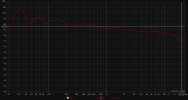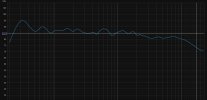Pareto Pragmatic
Addicted to Fun and Learning
Any number I give is really close to meaningless, since I have made so many incremental changes over time. And I have not listened to uncorrected since I got my last amp, which was a while ago. So it's really hard for me to judge. But I'll play.
Ok, I will assume that 100% improvement would mean taking it from unlistenable to perfect. 10% would mean a slight improvement, but obvious. Below 10% means you can hear it, but have to listen to hear it. 50% would mean I would not want to listen without it, but I could, and could probably get used to it over time if I only listened to that for a week. On that scale, I would put recapping 40 year old speakers at 25%. Running a dedicated power line to get stuff off my 100 year old wiring more like 40%. Those were both noise reductions of course.
I am not sure if we are talking about all room correction, or just "automatic" room correction as with an AVR. For automatic, it really depends on the curve. My AVR does a good job of fitting to a curve, I just hate the curve. Too bassy, too rolled off on top. But if I drop the bass 3dB and up the treble 1dB and roll the bass off below 40, on top of whatever it does for correction, it's pretty good. Flat enough, but still issues with some room modes at higher volumes.
So, thinking about what I have now and how I have corrected it (still have some fine tuning to do on some of my options for playing sound since I have not had a calibrated mic for very long), I would put it at 50%. BUT I have a very problematic room, with multiple modes including a 30hz mode that is crazy huge due to a very bouncy floor. And a sub 20hz mode at very high SPL. When those get going, they get GOING. So for me, the improvement comes from being able to play a bit louder before the room modes go crazy. And more importantly, knowing when they are likely to go crazy so I can keep things just below that level.
Pre calibrated mic, using first a phone app then a non-calibrated mic jacked in to my 8 year old laptop and REW, probably more like 25% improvement. .
OTOH, my office, small speakers and a sub, correction gives me something more like 10%. Much lower SPLs, much less extensive corrections applied.
So final answer, 50%, but with a defined meaning of what 50% means for me.
Ok, I will assume that 100% improvement would mean taking it from unlistenable to perfect. 10% would mean a slight improvement, but obvious. Below 10% means you can hear it, but have to listen to hear it. 50% would mean I would not want to listen without it, but I could, and could probably get used to it over time if I only listened to that for a week. On that scale, I would put recapping 40 year old speakers at 25%. Running a dedicated power line to get stuff off my 100 year old wiring more like 40%. Those were both noise reductions of course.
I am not sure if we are talking about all room correction, or just "automatic" room correction as with an AVR. For automatic, it really depends on the curve. My AVR does a good job of fitting to a curve, I just hate the curve. Too bassy, too rolled off on top. But if I drop the bass 3dB and up the treble 1dB and roll the bass off below 40, on top of whatever it does for correction, it's pretty good. Flat enough, but still issues with some room modes at higher volumes.
So, thinking about what I have now and how I have corrected it (still have some fine tuning to do on some of my options for playing sound since I have not had a calibrated mic for very long), I would put it at 50%. BUT I have a very problematic room, with multiple modes including a 30hz mode that is crazy huge due to a very bouncy floor. And a sub 20hz mode at very high SPL. When those get going, they get GOING. So for me, the improvement comes from being able to play a bit louder before the room modes go crazy. And more importantly, knowing when they are likely to go crazy so I can keep things just below that level.
Pre calibrated mic, using first a phone app then a non-calibrated mic jacked in to my 8 year old laptop and REW, probably more like 25% improvement. .
OTOH, my office, small speakers and a sub, correction gives me something more like 10%. Much lower SPLs, much less extensive corrections applied.
So final answer, 50%, but with a defined meaning of what 50% means for me.



